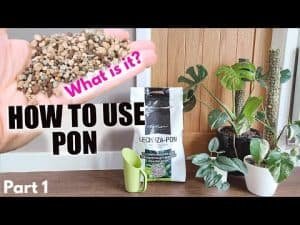What Is Pon For Plants? Move over, LECA, and make way for the soil! Pon is establishing himself as the dominant force in the plant world. Recent months have seen nothing but pon this and pon that in the world of plant collectors. Pon? I could deduce that plant collectors were repotting some of their plants into pon, but I couldn’t figure out why or what its aim was until much later. Fortunately, there is a wealth of knowledge available regarding this novel substrate.
We were interested in learning everything we could about this popular growing medium. Learn what pon is, why plant influencers and collectors use it, and how it has benefited the plants in their collections.
Contents
What Is Pon For Plants?
Any plant parent familiar with Pon will most likely name the brand Lechuza, a firm that manufactures a variety of self-watering planters that help prevent overwatering of the plants.
Why Are People Using Lechuza-Pon?
“The sensitivity to illnesses is minimized,” argues Lechuza, claiming that its pon keeps plants healthier than ordinary soil. The structurally stable plant substrate does not condense and retains its air-permeable structure when exposed to the elements for an extended period.
Difference between Pon and Other Medium
When compared to other mediums, the difference in leaf growth and roots in pon is substantially faster than in the others. The sub-irrigation of pon circulates the water rather than allowing it to sit in one place. I am hoping to see less root rot in the future, and I am confident that the fertilizing is well-balanced because it has been treated with high-quality fertilizer. The soil dries out at the top while remaining moist at the bottom, and the soil in pon appears to have a well-balanced moisture distribution.
It is possible to reduce the amount of time spent caring for plants when certain plants have been switched to pon. As a result, everyone should be looking forward to introducing people to this type of system so that they can enjoy their plants without stress while still keeping themselves active.
Benefits of Using Pon
An anonymous user shared their experience, saying, “My Hoya Wayetii was in LECA.” It has been idle for an extended period. So I made the decision to convert to pon as a substrate, and the change in leaf growth after a few weeks was incredible! My Hoya Rigida was rooted in Perlite when I brought it home, and it quickly sprouted two new leaves after being transplanted to pon. I’ve also experimented with re-rooting several Hoya nummularioides in a variety of media, including water, LECA, Perlite, and pon. It took less time for the cutting in pon to take root than the other cuts.”
Another user named Agatha also has given her opinion about the benefits of using the pon. “Agatha provides virtual plant consultations for plant parents, and she says that many of her clients have asked her for advice on how to care for their plants when they are away from home. The use of pon, LECA, and semi-hydro [growing plants without soil] is now recommended to folks who travel a lot because it’s a terrific way to control watering while still allowing the plants to obtain what they need.”
Agatha has now relocated most of her hoya collection to the pon flowering plant. She’s also swapped around some of her philodendrons and believes that monsteras would be a good fit in the space as well. Although pon can have a disadvantage with certain plants, she explained that it is possible to exchange larger plants. “This is largely due to the fact that pon can take up a lot of space if you mix it yourself, but it is possible,” she added. I strongly advise you to experiment with hoyas, philodendrons, and even monsteras! I also recommend that you make your own PON because it is more cost-effective.”
Conclusion: What Is Pon For Plants?
We hope you’ve gained enough knowledge to get started on your soilless growing journey if you’ve read this far. It’s impossible to cover all of the procedures and nuances in one post; however, specific Facebook groups, such as Semi-Hydroponics for Houseplants or Lechuza-Pon and DIY Pon, can be a fantastic resource for tried and true tips and answers to your burning questions.
Frequently Asked Questions (FAQ)
What is semi-hydro?
Like many others, Fair began her gardening career by putting seeds in the dirt. Then, after successfully propagating cuttings in the water and discovering that they can continue to grow in it, she began experimenting with soilless mediums to see what would happen. That was two years ago, and Fair has since converted the vast majority of her plants to semi-hydro, primarily for the simplicity of upkeep and the reduced risk of root rot that comes with it.
Reduced maintenance
Using a water reservoir reduces the frequency with which the plant must be watered, as the plant only takes up water at the required rate.
Reduced risk of root rot
Root rot can be reduced in severity by eliminating soil-borne organic microorganisms and allowing the plant to take up the amount of water that it requires, respectively. Soilless media do not clump or become saturated in the same way as the soil does when over-watered, allowing the plant to receive more aeration, which promotes healthy root growth.
No more fungus gnats?
An added benefit and one that many people identify as the primary reason for switching to semi-hydro is the elimination of fungus gnats from home. Despite this, Fair has reported encountering fungus gnats while working with Perlite. [Fair]
Re-useable Potting Mediums
The fact that soilless potting media can be reused for an extended period is a significant advantage of this method of growing plants. They only require thorough washing and rinsing before they can be reused.



